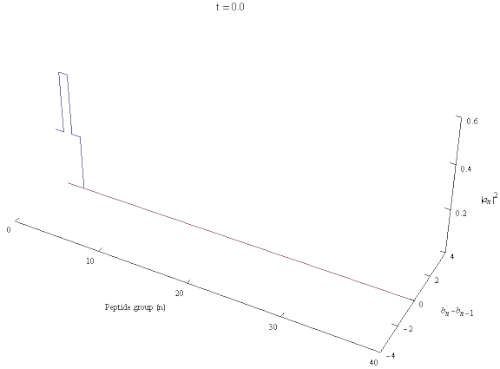
In quantum biology, the Davydov soliton (after the Soviet Ukrainian physicist Alexander Davydov) is a quasiparticle representing an excitation propagating along the self-trapped amide I groups within the α-helices of proteins. It is a solution of the Davydov Hamiltonian.
The Davydov model describes the interaction of the amide I vibrations with the hydrogen bonds that stabilize the α-helices of proteins. The elementary excitations within the α-helix are given by the phonons which correspond to the deformational oscillations of the lattice, and the excitons which describe the internal amide I excitations of the peptide groups. Referring to the atomic structure of an α-helix region of protein the mechanism that creates the Davydov soliton (polaron, exciton) can be described as follows: vibrational energy of the C=O stretching (or amide I) oscillators that is localized on the α-helix acts through a phonon coupling effect to distort the structure of the α-helix, while the helical distortion reacts again through phonon coupling to trap the amide I oscillation energy and prevent its dispersion. This effect is called self-localization or self-trapping.[3][4][5] Solitons in which the energy is distributed in a fashion preserving the helical symmetry are dynamically unstable, and such symmetrical solitons once formed decay rapidly when they propagate. On the other hand, an asymmetric soliton which spontaneously breaks the local translational and helical symmetries possesses the lowest energy and is a robust localized entity.[6]
- ^ Georgiev, Danko D.; Glazebrook, James F. (2019). "On the quantum dynamics of Davydov solitons in protein α-helices". Physica A: Statistical Mechanics and Its Applications. 517: 257–269. arXiv:1811.05886. Bibcode:2019PhyA..517..257G. doi:10.1016/j.physa.2018.11.026. MR 3880179. S2CID 53688720.
- ^ Georgiev, Danko D.; Glazebrook, James F. (2019). "Quantum tunneling of Davydov solitons through massive barriers". Chaos, Solitons and Fractals. 123: 275–293. arXiv:1904.09822. Bibcode:2019CSF...123..275G. doi:10.1016/j.chaos.2019.04.013. MR 3941070. S2CID 128306516.
- ^ Davydov, Alexander S. (1973). "The theory of contraction of proteins under their excitation". Journal of Theoretical Biology. 38 (3): 559–569. Bibcode:1973JThBi..38..559D. doi:10.1016/0022-5193(73)90256-7. PMID 4266326.
- ^ Davydov, Alexander S. (1977). "Solitons and energy transfer along protein molecules". Journal of Theoretical Biology. 66 (2): 379–387. Bibcode:1977JThBi..66..379D. doi:10.1016/0022-5193(77)90178-3. PMID 886872.
- ^ Davydov, Alexander S. (1979). "Solitons, bioenergetics, and the mechanism of muscle contraction". International Journal of Quantum Chemistry. 16 (1): 5–17. doi:10.1002/qua.560160104.
- ^ Brizhik, Larissa; Eremko, Alexander; Piette, Bernard; Zakrzewski, Wojtek (2004). "Solitons in α-helical proteins". Physical Review E. 70 (3 Pt 1): 031914. arXiv:cond-mat/0402644. Bibcode:2004PhRvE..70a1914K. doi:10.1103/PhysRevE.70.011914. PMID 15524556.


